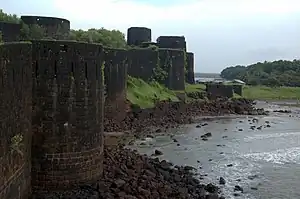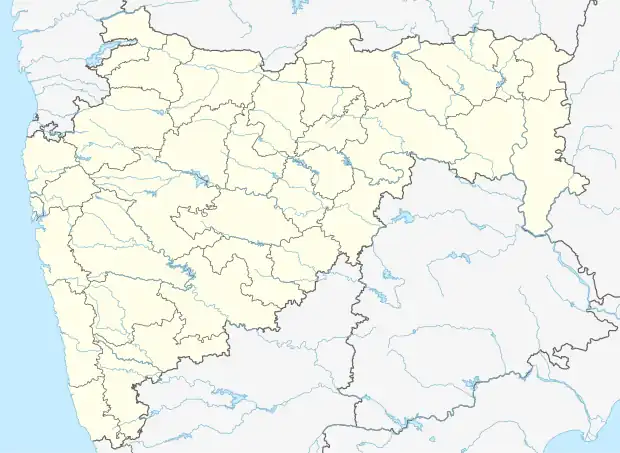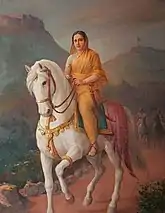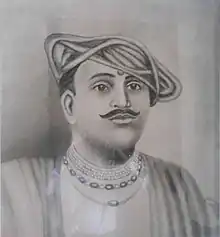| Vijaydurg Fort | |
|---|---|
विजयदूर्ग किल्ला | |
| Sindhudurg District, Maharashtra | |
 Bastions of Vijaydurg fort | |
 Vijaydurg Fort | |
| Coordinates | 16°33′39″N 73°20′00″E / 16.5607°N 73.3334°E |
| Type | Sea fort |
| Site information | |
| Open to the public | Yes |
| Site history | |
| Built | 1193 |
| Built by | Bhoja II |
| Materials | Stone, Mortar |
Vijaydurg (sometimes written as Viziadurg), the oldest fort on the Sindhudurg coast, was constructed during the regime of Raja Bhoja II of the Shilahar dynasty (construction period 1193-1205) and restructured by Chhatrapati Shivaji Maharaj.[1][2][3]
Earlier, the fort encompassed an area of 5 acres (20,000 m2) and was surrounded by sea on all four sides. Over the years the eastern trench was reclaimed and a road constructed thereon. Presently the area of fort is about 17 acres (69,000 m2) and is surrounded by the Arabian Sea on three sides. Shivaji extended the area of the fort by constructing three walls on the eastern side, each 36 metres high. He also constructed 20 bastions.[3]
Vijaydurg Fort was called the "Eastern Gibraltar", as it was virtually impregnable.[4] Its locational advantages include the 40 km long Waghotan/Kharepatan creek. Large vessels cannot enter the shallow water of this creek. Also, Maratha warships could be anchored in this creek and yet remain invisible from the sea. It is a protected monument.[4][5]
Etymology
The name Vijaydurg comes from two words, "Vijay" meaning victory and "Durg" meaning fort. The fort was earlier known as "Gheria", as it is situated close to the village of "Girye". Shivaji captured this fort from Adil Shah of Bijapur in 1653 and renamed it as "Vijay Durg" as the then Hindu solar year's name was "Vijay" (Victory).[4]
Location
Vijaydurg fort is located at the tip of the peninsular region of Vijaydurg in Devgad Taluka, of district Sindhudurg. It is one of the several coastal forts on the western coast of Maharashtra, India. It is surrounded by water on all the four side but connected to the land through a narrow road. The port adjacent to the fort is a natural port and is still used by local fishermen.[4]
History
In 1653, Chatrapati Shivaji Maharaj captured this fort from Adil Shah of Bijapur and renamed it as "Vijay Durg". The original name of the fort was "Gheria" and the first fortification appears to have been constructed in 1200 during the regime of Raja Bhoj II. Chatrapati Shivaji Maharaj developed Vijaydurg as an important base for Maratha warships.[4]
Maratha Empire looked to be in a decline after the death of chatrapati Shivaji Maharaj in 1680, when his son and successor Sambhaji was captured by Mughal Emperor Aurangzeb and brutally tortured to death on 21 March 1689. Later in that year, the fort of Raigad fell in the hand of Mughals. Wife of Shambhaji Maharaj and his infant son Shahu Maharaj along with many others were captured and were treated as state prisoners.[4]
Shivaji Maharaj's second wife's son Raja Ram then took in charge of the Maratha Empire. Inspired by the valiant death of Shambhaji Maharaj, they fought back against the Mughals. It was during his reign Kanhoji Angre alias Conajee Angria became admiral of naval army of the Marathas. In 1698, Kanhoji made Vijaydurg the capital of his territory along the coast.[4]
In 1700, Raja Ram died. Tara Bai, the brave widow of Raja Ram took over the control of the Maratha Empire. Putting her infant son on the Maratha throne styled as "Shivaji II", Tara Bai led successful operations against the Mughal from 1700 to 1707. Simultaneously due to his growth, Kanhoji Angre came to be regarded as the most "Powerful and independent Naval Chief of West coast of India". Tarabai gave Kanhoji title of Sarkhel (Admiral). At one time Kanhoji Angre was master of the whole coast from Bombay (Now Mumbai) to Vengurla.[4]
- The successors of Maratha Empire
 Maharani Tarabai lead the Marathas in the 27-year war with Mughals after death of her husband Rajaram
Maharani Tarabai lead the Marathas in the 27-year war with Mughals after death of her husband Rajaram Sarkhel Kanhoji Angre. Admiral of Maratha Navy 1698 - 1729
Sarkhel Kanhoji Angre. Admiral of Maratha Navy 1698 - 1729
Aurangzeb died in 1707 and Shahu was released from the clutches of Mughals. He challenged Tarabai and her son's legitimacy to the Maratha throne. The Marathas were divided but ultimately Shahu won the right to the throne as Chhatrapati and Tarabai was retreated to rule a small area of Kolhapur under the name of his son Shivaji II in 1713. She was later overthrown and imprisoned till her death by her husband's second wife Rajas Bai.[4]
In the same year, Shahuji sent his Peshwa (Prime Minister), Balaji Vishwanath from his headquarters at Satara to negotiate with Kanhoji Angre. Kanhoji agreed to acknowledge allegiance to Satara and shift his loyalty from Tarabai. In return Kanhoji was confirmed command of the Maratha fleet, and granted twenty-six forts and fortified places with their dependent villages.[4]
Vijaydurg is said to be the oldest fort in Sindhudurg coast. In the Pre-Independence era it was also known as "Eastern Gibraltar". This is because the fort was almost unconquerable. Under the leadership of Kanhoji Angre, it withstood many naval attacks by the British and the Dutch. Kanhoji Angre died on 4 July 1729 and the Angres control of the fort ended in 1756, after the Peshwa-British Alliance defeated the Angres clan. In 1818 Vijaydurg was completely in the hand of the British Empire.[4]
Battle of Vijaydurg
| Battle of Vijaydurg | |||||||
|---|---|---|---|---|---|---|---|
 The Capture of Gheria | |||||||
| |||||||
| Belligerents | |||||||
|
|
| ||||||
| Commanders and leaders | |||||||
|
|
| ||||||
| Strength | |||||||
|
2000 men |
500 British marines | ||||||
| Casualties and losses | |||||||
|
500+ men | Nil | ||||||
After the death of Kanhoji Angre, there were two short reigns by Sarfoji and Sambhaji. The two brothers Manaji and Tulaji started fighting for the Angre throne. Nanasaheb Peshwe had intervened in the disputes between Manaji and Tulaji. This created two spheres of influence, Manaji in the north at Kulaba and Tulaji in the south at Vijaydurg. Tulaji Angre was favored by Shahu and was appointed as Sarkhel (Admiral) of the Maratha Navy. This was against the will of Nanasaheb Peshwa.[6]
Sarkhel Tulaji
Tulaji was brave and a much more skillful seaman than Manaji. This had gained him the favor of Shahu. In a brief span, he had surpassed the record of his predecessors in the number of English ships captured: Charlotte of Madras, William of Bombay, Svern of Bengal and, Darby, Restoration, Pilot, Augusta and Dadabhoi of Surat. He had also captured Anjanvel from the Siddis of Janjira. Another reason for the Peshwa to go against Tulaji was that, Tulaji refused to admit the Peshwa as his superior, maintaining that both were equal servants of the Chhatrapati. He refused to pay revenue contribution and even annoyed the Peshwa by raiding his territory. Nanasaheb could do nothing as long as Shahu was alive, but after his death in 1749, Peshwa was free to wreck his vengeance on Tulaji.[6]
Death of Shahu and rise of Peshwa
After the death of Shahu, Peshwa was the next most influential ruler among the ones with huge armies and numerous land forts under his command or at his disposal under ownership of his vassals. Nanasaheb sought assistance of the English at Bombay to end Tulaji's reign. A treaty was signed according to which a ground force under command of the Peshwa and a naval force under command of the Company would attack and destroy Tulaji. Among other articles, the treaty provided that Fort Vijaydurg, when captured, would be given to the Peshwa.[6]
Fall of Suvarnadurg
In 1755, Commodore James of Bombay attacked the fort Suvarnadurg while the Peshwa's army started capturing land and other coastal forts of Angre. This isolated Suvarnadurg from landward. Commodore James first bombarded the fort from the west. 800 shots and shells were expended at a range of 100 yards, but the walls did not collapse.[7] He then entered the channel between the fort and the coast and fired on the eastern face as well as the main gate. Both gave way. Some of the garrison tried to escape from the fort by a tunnel running into the sea, but were discovered and killed.[8] Considerable damage had been caused inside the fort by the bombardment and the garrison, finding no hope of relief or reinforcements, surrendered. Commodore James returned to Bombay for the monsoons.
Attack on Vijaydurg
After the fall of Suvarnadurg and all other forts of the Angre, Vijaydurg was the only fort left under the command of Tulaji. In 1756, a large force under Admiral Watson converged on Vijaydurg. Watson had arrived at Bombay from eastern waters and had with him Colonel Clive with 500 marines. The English ships took station with Watson flying his flag on the Protector. Two bomb vessels were in the extreme east. The Maratha ships were anchored at the mouth of the creek, close to the fort. They all were bunched up, almost hull to hull. Amongst these was the Company's ship Restoration, which caught fire. The fire spread rapidly till the entire Angre fleet was destroyed, The bombardment of the fort had caused considerable damage inside the fort and magazine had been blown up.[6]
Fall of Vijaydurg
Tulaji, meanwhile had left the fort and gone to the Peshwa's camp seeking a negotiation but was promptly arrested and sent to one of the inland forts as a prisoner. The garrison was asked to surrender and in the absence of any response Clive landed his marines on 11 February 1756, entered and captured the fort. A huge amount of booty was captured. 250 pieces of cannons, stores and ammunition, 100,000 Rupees and 30,000 in valuable items fell into English hands.[6] Vijaydurg was not handed over immediately to the Peshwa as per the terms of the treaty. It was eventually given up but only after the Company obtained Bankot in exchange.[9]
End of Maratha Naval Supremacy
The battle of Vijaydurg marks the end of the Maratha Navy as a potent force.[9] The Maratha Admiral Dhulap captured some ships later. The Sawants of Sawantwadi, the Chhatrapati of Kolhapur and the Gaikwads of Baroda, all had a few ships. But the command of the seas, for all practical purposes had passed to the Company permanently. They achieved this in 1756 only because of the alliance with the Peshwa.[9]
Features of Architectural Interest
- According to unconfirmed reports, there is a 200 meter long, undersea tunnel from the fort to the palatial Dhulap house in the village.[10] Supposedly, the roof of the tunnel has been pinched to protect it from landslides and it is also well ventilated. Now the tunnel is partially blocked. If the presence of the tunnel can be confirmed, and the tunnel cleared, it could serve as a tourist attraction of historical and architectural interest.
- Recent oceanographic evidence supports the existence of an undersea wall, constructed out at sea at a depth of 8–10 meter depth undersea.[11] Made of laterite, the wall is estimated to be 122 meter long, 3 meter high & 7 meter broad. Attacking ships often met a watery grave after colliding against this wall. When the Siddhi of Janjira was going to attack Vijaydurg, he got a message from Portuguese telling him that they had lost 2 of their ships while they were nearing the fort.
- 1.5 km from the fort up the Waghotan Creek, exist the remains of a naval dock carved from rock.[12] This is where Maratha warships were built and repaired. The ships built here were of the 400-500 tonnage capacity. This 109 meter long and 70 meter wide dock faces the north side and is an achievement of Maratha naval architecture. Most of the smaller ships used to be docked near this small inner port.[13] The southern and eastern side is cut out of a natural rock and rest is dry masonry. In addition to this a number of grapnel and triangular stone anchors were noticed in the adjoining area of dockyard.[14]
- On the other hill in front of the fort a wall was built to deceive the enemy. When the enemy attacked the wall, he had already wasted his ammunition and before he could understand, he would be attacked by Marathas from the rear side.
- The Archaeological Survey of India had undertaken restoration and repair works for Maratha forts in Maharashtra which included Vijaydurg Fort along with Shivneri and Sindhudurg Fort.[15]
- The fort has many monuments, now in ruins which show the characteristics of Maratha architecture. The food storage and court are such classic examples.
- This fort also has a Khalbatkhana, where important meetings were held. There are only 3 forts that had a Khalbatkhana. They are Rajgad, Raigad and Vijaydurg.
Movies
The Vijaydurg Fort features in the movie Killa (The Fort), an Indian Marathi drama film directed by Avinash Arun. Killa's locations include Guhagar, the Vijaydurg Fort and Ganpatipule.[16][17] The cycle race between Chinmay (the lead character) and his friends to the fort lends the movie its title.
Some of the locals claim that Sir Joseph Norman Lockyer, a British scientist was observing a solar eclipse from this fort on 18 August 1868.[18] The y claim that during his observation that the Helium Gas was discovered on Sun in the form of a yellow flame.[19]
The published reports on the discovery of helium report, that helium was discovered by two scientists independently in 1868. French astronomer Jules Janssen observed helium emission lines on 18 August 1868 as a bright yellow line during a total solar eclipse in Guntur, India.[20] On 20 October of the same year, English astronomer Norman Lockyer observed a yellow line in the solar spectrum. He took the observation in West Hampstead, United Kingdom.[21]
Norman Lockyer set up an observation post at the Vijaydurg Fort for the Solar eclipse of January 22, 1898. In his report he does not mention that he ever had been to the Fort before.[22] On that occasion a platform was built.
World Helium Day
Since 2009 World Helium Day is celebrated at the Vijaydurg Fort.[23]
See also
References
- ↑ Coastal Konkan - Forts, Temples, Exotic Beaches
- ↑ Sen, Sailendra (2013). A Textbook of Medieval Indian History. Primus Books. p. 207. ISBN 978-9-38060-734-4.
- 1 2 "Top 5 Forts in Maharashtra: Revisiting History This Monsoon". India Destinations. 8 July 2013. Retrieved 8 December 2015.
- 1 2 3 4 5 6 7 8 9 10 11 Konkan Odyssey - Part 4
- ↑ "List of the protected monuments of Mumbai Circle district-wise" (PDF). Archived from the original on 6 June 2013.
{{cite web}}: CS1 maint: unfit URL (link) - 1 2 3 4 5 Naravane, M. S.; Battles of the Honorary East India Company: Making of the Raj, op cit page 103, New Delhi, 2006
- ↑ Keay, I., op cit page 267
- ↑ Keay, I., op cit page 268
- 1 2 3 Naravane, M. S.; Battles of the Honorary East India Company: Making of the Raj, op cit page 104, New Delhi, 2006
- ↑ Vijaydurg Marvels
- ↑ TOI EPaper - Underwater Secrets!
- ↑ Nature Club Holidays - One Day Forts
- ↑ konkanonline.com - Vijaydurg Fort
- ↑ India Travel Guide - Forts - Maharashtra - Vijaydurg
- ↑ Maharaj-citadels-are-crumbling-with-neglect/1/372686.html India Today - Shivaji Maharaj's citadels are crumbling with neglect
- ↑ Scroll.in - Decorated Marathi movie ‘Killa’ is a sensitive portrayal of the wonder and blunder years
- ↑ Diary of a Dancebee - Film Review | Killa (The Fort)
- ↑ "Helium was discovered on this day in space instead of Earth!". India Today. 18 August 2017. Retrieved 18 August 2021.
- ↑ Williams, Matt (14 March 2016). "Who Discovered Helium?". Universe Today. Retrieved 18 August 2021.
- ↑ Kochhar, R. K. (1991). "French astronomers in India during the 17th – 19th centuries". Journal of the British Astronomical Association. 101 (2): 95–100. Bibcode:1991JBAA..101...95K.
- ↑ Cortie, A. L. (1921). "Sir Norman Lockyer, 1836-1920". Astrophysical Journal. 53: 233–248. Bibcode:1921ApJ....53..233C. doi:10.1086/142602.
- ↑ Lockyer, Norman; Chisholm-Batten, R. N.; Pedler, A. (1901). "Total Eclipse of the Sun, January 22, 1898. Observations at ViziadrugAuthor". Philosophical Transactions of the Royal Society of London. 197: 151–227. Bibcode:1901RSPTA.197..151L. doi:10.1098/rsta.1901.0017. JSTOR 90835.
- ↑ "Helium: a discovery you can't take 'lightly'". Deccan Herald. 25 August 2018. Retrieved 18 August 2021.